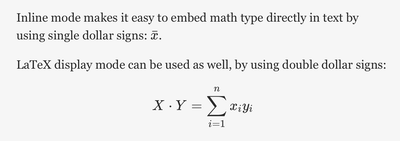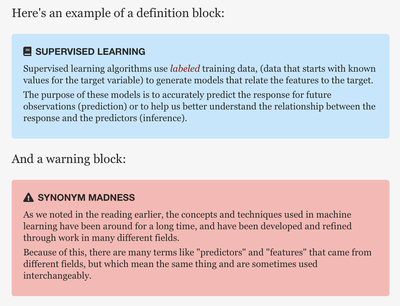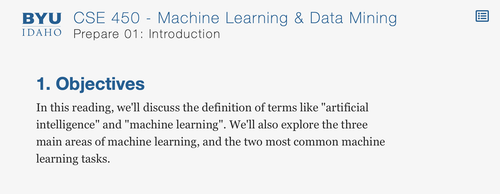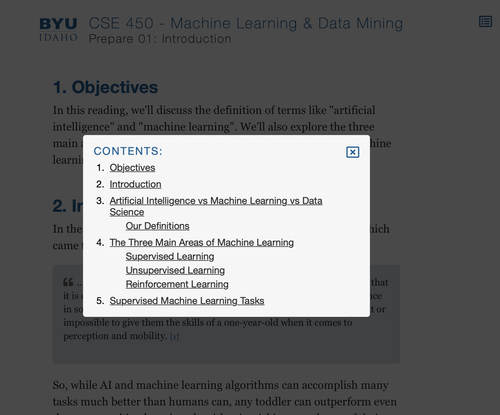This repository holds the public course materials for CSE 450.
The materials for this course may be found in the /source folder. Most content is written in markdown format, a popular markup language with plain text formatting.
The course's build toolchain copies all directories and files from the /source folder to the /docs folder. The contents of this folder are automatically published to the course site published on GitHub Pages.
All markdown files are transformed by the build script into HTML. A default template is used for this transformation (/templates/default.html). The default template loads a few CSS and JS libraries, such as:
- LaTeX typesetting using Khan Academy's Katex library
- Icon fonts via the FontAwesome icon library
- Code syntax highlighting provided by the Highlight.js library
- Automatic smart quote transformation via smartquotes.js
The build toolchain is based on Python 3 (tested with 3.8.2). Aside from the standard libraries, the build script has one dependencies:Python markdown. It can be installed in the standard way:
pip install markdown
While not required, it is recommended that you use a virtual environment.
Once the dependencies are install, the build process can be run from the repository root via a makefile by typing:
make
If your system doesn't have make installed, you can also manualy run the build script:
python3 ./build-toolchain/build-site.py -s ./settings.cfg
The settings.cfg file contains site-specific settings for the build process. By default, the script will look in the current directory for settings.cfg, but you can also specify its path using the -s flag.
An alternate configuration settings-local.cfg is also provided, which changes the host URL to localhost. This allows easy local development and testing with something like MAMP.
A local build rule is also provided in the makefile for convienience:
make local
The transformed HTML data is inserted into the template wherever the {{CONTENT}} placeholder is found.
Additional placeholders include {{TITLE}}, {{TOC}}, {{URLROOT}}, and {{BODYCLASS}}.
When the markdown file is parsed, metadata at the top of the file is indexed by the meta-data markdown extension.
---
title: Prepare 01: Introduction
template: ./templates/some-template.html
body-class: index-page
---
Any metadata tags may be included in the metadata section, but the only values currently used by the build toolchain are title, tempalte, and body-class.
The title and body-class values are inserted into the template at their corresponding placeholders.
The template value may be used to override the HTML template used for a particular markdown file. To do so, simply specify the path to the desired template in the markdown file's header. The path should be relative to the repository's root folder.
New templates should generally only be used if you need a significant change to the structure of the HTML.
If you only need page-specific styling, the body-class metadata value will allow you to selectively style pages based on the class of their body tags.
The {{URLROOT}} value comes from settings.cfg.
Aside from the standard markdown syntax, the build toolchain provides some additional extensions. Note that these extensions simply output raw HTML.
All styling is either provided by external libraries or CSS files linked in the default template.
LaTeX like formatting is provided for the default template by Khan Academy's Katex library. Equations may be embeded in markdown using one of two formats.
Inline mode makes it easy to embed math type directly in text by using single dollar signs: $ \bar{x} $.
LaTeX display mode can be used as well, by using double dollar signs:
$$ X \cdot Y = \sum_{i=1}^{n} x_iy_i $$
Language specific code formatting is provided using the fenced-code extension and highlight.js. Note that GitHub's backtick format is preferred:
```python
# Verbose version
def mean(X):
total = sum(X)
length = len(X)
return total / length
# More compact version
def mean(X):
return sum(X) / len(X)
```
Footnotes can be used according to the standard footnotes extension syntax:
"...as the number of demonstrations has mounted, it has become clear
that it is comparatively easy to make computers exhibit adult-level
performance in solving problems on intelligence tests or playing
checkers, and difficult or impossible to give them the skills of a
one-year-old when it comes to perception and mobility." [^1]
...
[^1]: [Mind Children, by Hans Moravec (Harvard University Press, 1988)](http://www.hup.harvard.edu/catalog.php?isbn=9780674576186&content=reviews)
Admonition blocks allow you to specify structured asides, notes, warnings, etc...
Here's an example of a definition block:
!!! def "Supervised Learning"
Supervised learning algorithms use *labeled* training data,
(data that starts with known values for the target variable)
to generate models that relate the features to the target.
The purpose of these models is to accurately predict the
response for future observations (prediction) or to help
us better understand the relationship between the response
and the predictors (inference).
And a warning block:
!!! warning "Synonym Madness"
As we noted in the reading earlier, the concepts and techniques
used in machine learning have been around for a long time, and
have been developed and refined through work in many different
fields.
Because of this, there are many terms like "predictors" and
"features" that came from different fields, but which mean
the same thing and are sometimes used interchangeably.
The format for these blocks is:
!!! <type> "TITLE"
Content
Generated HTML is in this format:
<div class="admonition warning">
<p class="admonition-title">Synonym Madness</p>
<p>As we noted in the reading earlier, the concepts and
techniques used in machine learning have been around for a
long time, and have been developed and refined through work
in many different fields.</p>
<p>Because of this, there are many terms like "predictors" and
"features" that came from different fields, but which mean
the same thing and are sometimes used interchangeably.</p>
</div>
There are no predefined admonition types. The appearance and icons used for a given type are all controlled by CSS formatting. The default template supports note, warning, and def.
A table of contents is automatically generated based on the heading structure and inserted into the default template.
Heading numbering is not part of the table of contents, but is controlled via CSS counters and is completely optional.
In the default template, the table of contents is hidden until the table of contents icon in the upper right corner of the window is clicked.
Visible:






